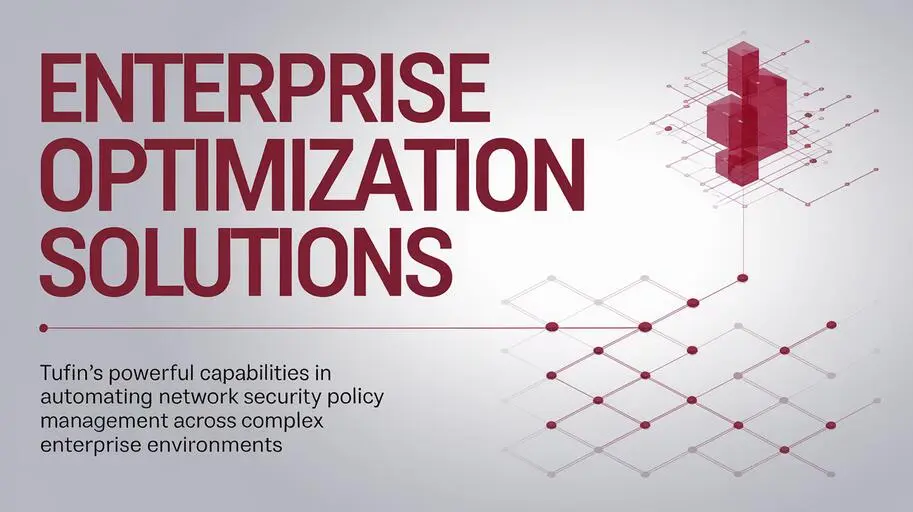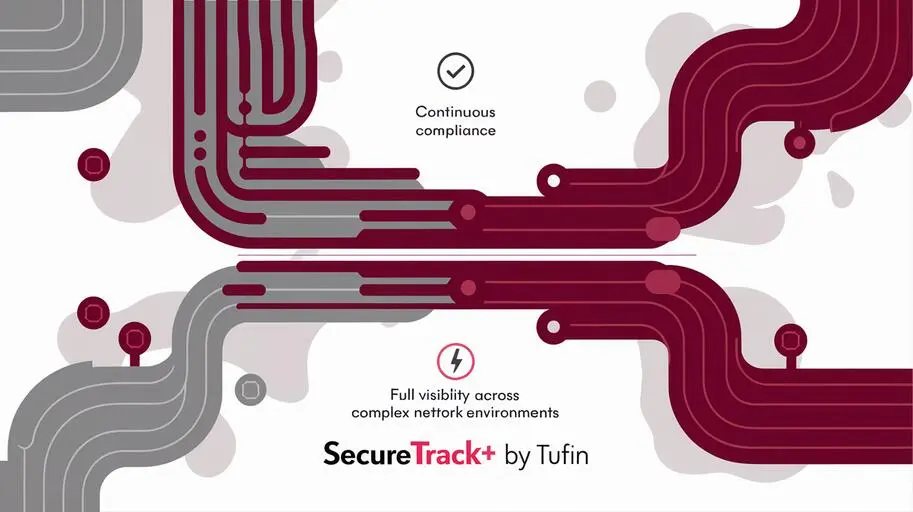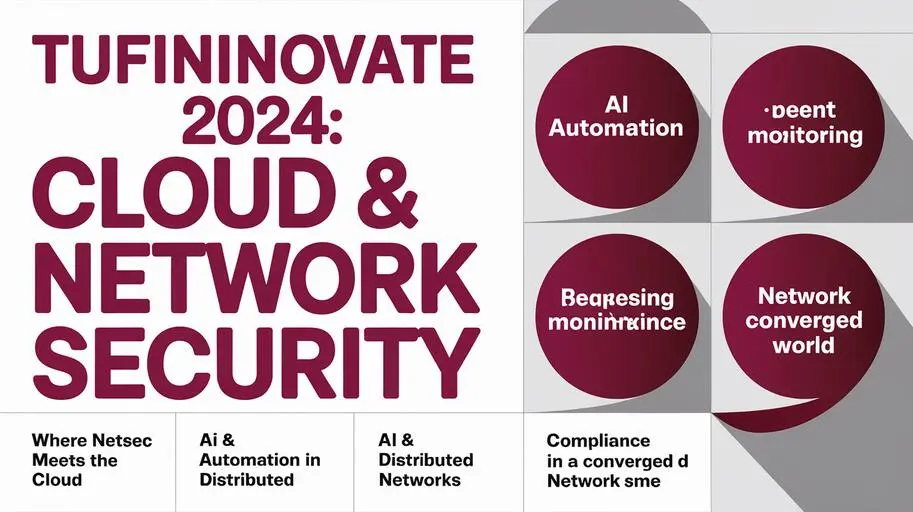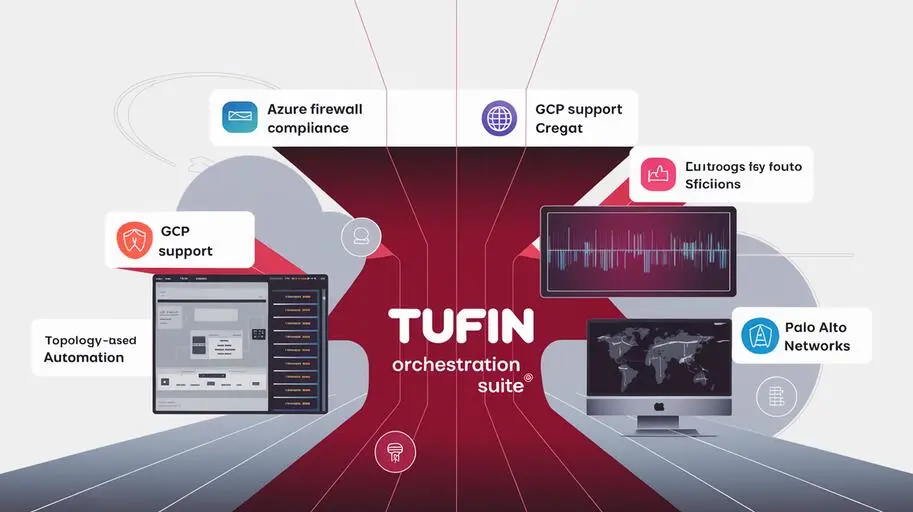
Modern organizations face the need to manage complex and dynamic network infrastructures, especially in hybrid cloud environments. Managing firewall rules scattered across various platforms is becoming an increasingly complex task, requiring significant time and creating a risk of delays in incident response due to manual configuration checks. Instead of error-prone manual management, Tufin Orchestration Suite automates security policy management, configuration changes, and vulnerability management processes in the network infrastructure, helping organizations meet regulatory requirements and reduce risks.
Automating Network Security Management with Tufin
Tufin Orchestration Suite provides a unified platform for managing security policies, configuration changes, and risks in heterogeneous network environments. This can include firewalls (e.g., Check Point, Cisco, Fortinet, Palo Alto Networks), cloud platforms (AWS, Azure, GCP), and microsegmentation technologies (Kubernetes network policies, VMware NSX).
Key Tufin capabilities for automating network security management:
- Centralized security policy management: Tufin allows you to create unified security policies that are automatically translated into firewall configurations from different vendors. Management of access lists, security zones, and other security objects is supported. For example, you can set a rule that prohibits access to a specific IP address from a specific network, and Tufin will automatically apply this rule to all relevant firewalls, regardless of their vendor.
- Configuration change automation: Tufin automates the addition, modification, and deletion of firewall rules, the configuration of VPN tunnels, and the modification of routing parameters. The configuration change process includes a workflow with approve/reject capabilities, as well as rollback mechanisms in case of a failed change. For example, you can schedule the addition of a new rule to access a server at a specific time, and Tufin will automatically perform this change and verify its correctness.
- Continuous compliance monitoring: Tufin automatically checks whether firewall configurations comply with PCI DSS, HIPAA, GDPR requirements and generates reports for auditors. For example, Tufin can detect that a firewall is not configured in accordance with PCI DSS requirements and provide a report indicating specific violations and recommendations for their remediation.
Risk Management with Tufin Orchestration Suite
Tufin provides tools for identifying, assessing, and prioritizing risks in the network infrastructure.
Risk identification and assessment:
- Automatic vulnerability discovery and assessment: Tufin integrates with vulnerability scanners such as Nessus, Qualys, and Rapid7 through APIs and automatically performs scanning of network devices. The scan results are imported into Tufin and correlated with network configuration information to identify potential risks. Vulnerabilities identified by CVE and CVSS are supported. For example, Tufin can detect a CVE-2023-46604 vulnerability in Apache ActiveMQ and map it to a server on the network to determine the potential risk. The scanning frequency and types of scanned vulnerabilities are configured by the administrator.
- Threat modeling: Tufin models threats using a threat knowledge base and analyzing potential attack paths. Various types of attacks are analyzed, such as exploitation of known vulnerabilities, brute-force attacks, and DDoS attacks. The analysis algorithm takes into account the network topology, firewall configuration, and other factors to determine the most likely penetration paths.
- Risk calculation and visualization: Tufin calculates risk based on the likelihood of vulnerability exploitation, potential business damage, and asset criticality. Risks are visualized as heatmaps or graphs, allowing for quick identification of the most vulnerable areas of the network. Factors such as CVSS score, business criticality of the asset, and the availability of a publicly available exploit are considered when calculating the risk. For example, a server with critical data and a vulnerability with a high CVSS score will have a higher risk than a server with non-critical data and a vulnerability with a low CVSS score.
Vulnerability prioritization and remediation:
- Automatic vulnerability prioritization: Tufin automatically prioritizes vulnerabilities based on risk assessment, business criticality of assets, and exploit availability. For example, vulnerabilities that could lead to confidential data leakage or business process outages will be prioritized higher.
- Providing recommendations for vulnerability remediation: Tufin provides recommendations for vulnerability remediation, including configuration changes, patch installation, and implementation of compensating measures. Recommendations may include specific steps for changing the firewall configuration or installing the necessary patch. Tufin does not offer automatic script generation for remediation but provides detailed instructions.
- Automatic task generation: Tufin integrates with task management systems such as Jira and ServiceNow to automatically generate tasks for vulnerability remediation and track their completion. For example, when a vulnerability is detected, Tufin automatically creates a task in Jira for the responsible employee, indicating detailed information about the vulnerability and recommendations for its remediation.
Vulnerability Management: From Discovery to Remediation
Tufin Orchestration Suite provides a comprehensive vulnerability management process, covering all stages: discovery, assessment, prioritization, remediation of vulnerabilities, and monitoring.
Vulnerability Discovery and Assessment in Tufin:
- Integration with leading vulnerability scanners: Tufin is guaranteed to be compatible with Nessus (version 8 and above), Qualys (Cloud Platform), and Rapid7 (InsightVM). Integration allows you to automatically detect vulnerabilities in the network infrastructure.
- Contextual vulnerability analysis: Tufin takes into account the network configuration when analyzing vulnerabilities. For example, if a vulnerable server is behind a firewall with properly configured rules, the risk of vulnerability exploitation may be reduced. Tufin analyzes firewall rules to determine how well the vulnerable server is protected.
- Correlation of vulnerabilities with threat data: Tufin uses threat data from various sources, including commercial threat databases and open-source intelligence (OSINT), to identify the most dangerous vulnerabilities.
Prioritizing and Eliminating Vulnerabilities with Tufin:
- Vulnerability Ranking: Tufin ranks vulnerabilities based on risk assessment and business impact.
- Automatic Task Generation: Tufin automatically generates tasks to eliminate vulnerabilities and distributes them among responsible persons, using integration with Jira and ServiceNow.
- Automated Firewall Rule Updates: Tufin can automatically block traffic to a vulnerable server by creating a “deny” rule on the firewall. Tufin determines which rule to create by analyzing the traffic associated with the vulnerability and creating a rule that blocks only malicious traffic without disrupting legitimate traffic. Example: “When a vulnerability is detected in a web server, Tufin can automatically create a rule on the firewall that blocks traffic to that server from untrusted networks.”
- Integration with Change Management Systems: Tufin integrates with change management systems to control and track the vulnerability remediation process.
Monitoring and Reporting on Vulnerabilities:
- Continuous Monitoring: Tufin provides continuous monitoring of network security status and identifies new vulnerabilities.
- Security Status Reports: Tufin generates security status reports, including a list of vulnerabilities, their risk assessments, and remediation status.
- Compliance Reports: Tufin creates compliance reports that demonstrate efforts to manage risks and vulnerabilities.
Optimizing Security Policies and Achieving Compliance with Tufin
Tufin Orchestration Suite helps organizations optimize their security policies and ensure compliance with various regulatory standards such as PCI DSS, HIPAA, and GDPR.

Automating Compliance Checks:
- Automatic Detection: Tufin automatically detects deviations from regulatory requirements and security policies using predefined and customizable checks.
- Generating Audit Reports: Tufin generates audit reports demonstrating compliance with security standards. Examples of reports include reports on compliance with PCI DSS, HIPAA and GDPR.
- Providing Remediation Recommendations: Tufin provides recommendations for correcting identified deviations.
Optimizing Network Configurations:
- Visualizing Security Policies: Tufin visualizes security policies as a network diagram showing firewall rules. This allows you to quickly identify redundant or conflicting rules.
- Automatic Update of Firewall Rules: Tufin automatically updates firewall rules based on changes in network infrastructure and business requirements. Example: “When adding a new server to the network, Tufin can automatically create the necessary rules on the firewall to ensure access to this server.”
- Minimizing Errors: Tufin minimizes errors and risks associated with manual configuration management.
Tufin Integration with Other Security Systems
Tufin Orchestration Suite easily integrates with various security systems, such as SIEM, vulnerability scanners, change management systems, and cloud security platforms, to create a comprehensive and automated network security management system. For example, the integration of Tufin and SIEM allows you to correlate data about vulnerabilities and security events, which increases the effectiveness of incident response.
Integration Examples:
- Tufin + Splunk: Tufin sends data on changes to firewall configurations to Splunk for analyzing security events and identifying anomalies.
- Tufin + ServiceNow: Tufin creates requests in ServiceNow to eliminate vulnerabilities detected by the scanner.
Benefits of Tufin Integration:
- Improved Network Visibility: Integration provides improved network visibility and a more complete understanding of risks and vulnerabilities.
- Automated Workflows: Integration automates workflows for vulnerability detection and assessment, incident response, and compliance.
- Cost Reduction: Integration reduces security management costs by automating routine tasks and optimizing resource utilization.
Monitoring and Reporting on Risks in Tufin
Tufin Orchestration Suite provides monitoring and reporting capabilities that allow organizations to track the security status of their network, identify trends, and make informed decisions to improve security.
Monitoring network security status:
- Real-time Monitoring: Tufin monitors key metrics, such as the number of vulnerabilities, deviations from regulatory requirements, and security events, in real-time. You can also create your own metrics for monitoring.
- Customizable Dashboards: Tufin provides customizable dashboards that allow you to visualize security data in a convenient format. An example dashboard might display the total number of vulnerabilities by category, the status of PCI DSS compliance, and the number of security incidents in the last month.
- Event Alerts: Tufin sends security event alerts via email or other communication channels.
Reporting on Risks and Vulnerabilities:
- Security Reports: Tufin generates security reports containing detailed information about vulnerabilities, risks, and compliance status. Reports can be exported in PDF or CSV format.
- Audit Reports: Tufin provides audit reports demonstrating efforts to manage risks and vulnerabilities.
- Customizable Reports: Tufin allows you to generate reports in accordance with the specific needs of the organization.
The Advantages of Tufin in Managing Network Configuration Changes
Effective management of network configuration changes is critical to maintaining network stability, network security, and compliance. Tufin Orchestration Suite provides tools for automating and controlling the configuration change process, reducing risks and increasing efficiency.
Automation of the Change Management Cycle:
- Change Planning: defining tasks, resources, and implementation timeframes.
- Change Modeling: Tufin models changes, taking into account network topology, firewall configuration, and other parameters. This allows you to assess the impact of changes on network security and performance before they are actually implemented.
- Automatic Execution of Changes: Tufin automates the execution of changes, minimizing manual intervention and errors. Changes that do not require additional checks by a person can be automated.
- Verification After Making Changes: After making changes, Tufin performs verification, automatically or manually, using tools such as ping, traceroute, and traffic analyzers.
Benefits of Automating Change Management with Tufin:
- Reduced Downtime: fast and secure changes.
- Improved Compliance: compliance with security policies and standards.
- Error Reduction: automated processes minimize the human factor.
In conclusion, Tufin provides a solution for managing risks and vulnerabilities in modern network infrastructures. Tufin Orchestration Suite allows organizations to automate routine tasks, improve network visibility, optimize security policies, and ensure compliance, which in turn improves cybersecurity posture.
For more information about Tufin, please refer to the API documentation and code samples.
FAQs on: Risk and Vulnerability Management in Network Security with Tufin
-
What is Tufin and how does it help in managing network security?
Tufin is a comprehensive solution for automating risk and vulnerability management in network infrastructure. It ensures robust network security and compliance by automating security policies, configuration changes, and risk management in heterogeneous network environments. -
What are the main features of Tufin Orchestration Suite for automating network security management?
Tufin Orchestration Suite offers centralized security policy management, automation of configuration changes, and continuous compliance monitoring. It allows you to define, visualize, and enforce security policies, plan and implement configuration changes with minimal risk, and automatically detect deviations from regulatory requirements. -
How does Tufin help in identifying and assessing risks in the network infrastructure?
Tufin provides tools for automatic vulnerability detection and assessment, threat modeling, and analysis of potential attack paths, as well as calculating and visualizing risks based on the likelihood of exploiting vulnerabilities and the potential damage to the business. -
How does Tufin prioritize and remediate vulnerabilities?
Tufin automatically prioritizes vulnerabilities based on risk assessment and business criticality of assets, provides recommendations for vulnerability remediation (including configuration changes, patch installation, and application of compensating controls), and automatically generates tasks for vulnerability remediation and tracks their completion. -
With which vulnerability scanners does Tufin integrate?
Tufin integrates with leading vulnerability scanners, such as Nessus, Qualys, and Rapid7, for automatic vulnerability detection in network infrastructure. -
What reporting capabilities does Tufin provide in the field of vulnerability management?
Tufin provides security status reports that track the list of vulnerabilities, their risk assessment, and remediation status. Compliance reports are also generated, demonstrating efforts to manage risks and vulnerabilities. -
How does Tufin help optimize security policies and ensure compliance?
Tufin helps automate compliance checking, generate audit reports demonstrating compliance with security standards, and provide recommendations for correcting identified deviations. It also optimizes network configurations, visualizes security policies, and identifies redundant or conflicting rules. -
With which other security systems does Tufin integrate?
Tufin easily integrates with various security systems, such as SIEM, vulnerability scanners, change management systems, and cloud security platforms. -
What are the benefits of automating change management with Tufin?
Automating change management with Tufin reduces downtime, improves compliance, and reduces the number of errors associated with making changes to network configuration. -
What monitoring and reporting capabilities does Tufin offer for tracking network security status?
Tufin provides real-time monitoring of key security indicators, customizable dashboards for visualizing security data, and security event alerts. In addition, security reports are generated, containing detailed information on vulnerabilities, risks, and compliance status, as well as audit reports.




